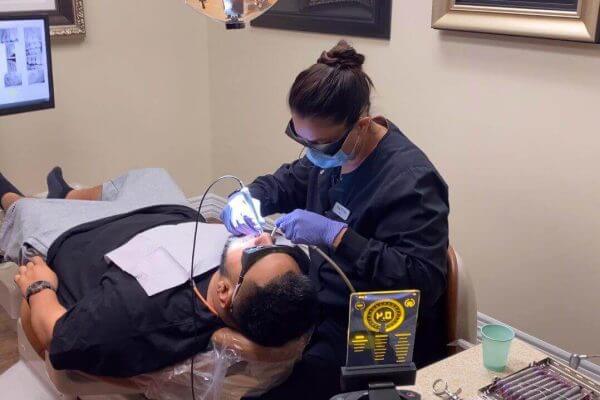What Is Fluoride Treatment?
Fluoride treatment is a proven and safe way to prevent tooth decay, especially in children who may not be adept at brushing their teeth effectively. At the dentist, fluoride treatment may be applied easily in several different ways, including varnish, foam, or gel.
- Varnishes are painted onto the teeth with a small brush. Only a small amount is used, and the varnish hardens fairly quickly before being brushed off within 4 to 12 hours.
- Foam is placed into a mouth guard, which is held in the mouth for 1 to 4 minutes.
- Gel can be painted on or applied using a mouth guard.
Whichever form of fluoride treatment is used, the goal is to help strengthen the teeth and protect against tooth decay.

What is Tooth Sealant?
Dental sealants (also known as a tooth sealant) are thin, plastic coatings that are painted onto the back teeth (the permanent molars) to help prevent tooth decay on the chewing surfaces of the teeth. Once the sealant is painted on, it forms a protective shield over the enamel of the tooth.
The back teeth (molars) are particularly vulnerable to tooth decay because they are more difficult to keep clean. Research has shown that using tooth sealants reduces the risk of tooth decay in molars by almost 80%. In 2016, the Centers for Disease Control (CDC) stated that “school-age children without sealants have almost three times more cavities than children with sealants.”
Fluoride Treatment versus Tooth Sealant
Fluoride treatments and tooth sealants are not an “either/or” option. Both are preventative treatments that are recommended for children who have gotten their permanent teeth by the American Dental Association (ADA).
In other words, it is highly recommended that children get fluoride treatments every 6 months until the age of 16. Dental sealants are recommended for all children once they get their permanent molars, which is about age 6 for first molars and age 12 for second molars.

Who Should Get Fluoride Treatments
Dental fluoride treatment for kids is recommended once a child starts getting their teeth. The American Academy of Pediatrics recommends infants receive an oral health risk assessment by the age of 6 months. All children should be established with a dentist by the age of 12 months. At that point, the dentist can make specific recommendations on when to begin fluoride treatments.
The general guideline from the American Academy of Pediatrics is that children between the ages of 6 months and 16 years receive a fluoride treatment every 6 months to strengthen and protect primary and permanent teeth. Most dental insurance typically covers fluoride treatments for children 13 years and younger. However, each patient should check the details of their plan for coverage.
Adult fluoride treatment for is recommended if you have the following conditions.
- Dry mouth conditions (known as xerostomia) can lead to increased tooth decay as the lack of saliva makes it more difficult to neutralize acids and wash away food particles. Dry mouth can be caused by certain medications (such as those for allergies, anti-anxiety, or high blood pressure), and diseases such as Sjögren’s syndrome, or head and neck radiation.
- Gum disease (also known as periodontitis).
- A history of frequent cavities (defined as a cavity every year or every other year).
- Crowns, bridges, or braces, which can put teeth at risk of decay.
The dental professionals at Lakefront Family Dentistry can answer any questions about the appropriateness, timing, and usefulness of fluoride treatment for adults or children, especially for adults with the conditions listed above.

Who Should Get Tooth Sealants
As stated earlier, it is recommended that all children receive tooth sealants once their permanent molars erupt—around the age of 6 for first molars and around the age of 12 for second molars. Dental sealants have been proven to be safe and extremely effective at protecting these important teeth.
The process of applying sealants is quick and painless. First, our dental professionals will clean and dry the teeth. A gel will then be applied to the teeth. This gel helps to “rough up” the surface of the teeth so the sealants can create a strong bond. The gel will then be rinsed off, and the teeth will be dried. The sealant will then be brushed onto the teeth with a small brush. A special blue light will be used to harden the sealant into place.
Once the tooth sealants are in place, they form a protective shield that blocks germs and food particles. The application of sealants has been shown to protect against 80% of cavities for 2 years. After that, the sealants protect against 50% of cavities for up to 4 years. However, studies have shown most sealants are still effective 9 years after placement.
Tooth sealants can be clear, white, or slightly tinted. They are usually invisible when a child talks or eats. However, there is a possibility that a sealant can fall off. For this reason, sealants should be checked at each dental appointment. If a sealant is missing, it can be easily replaced.
Most dental insurance plans cover the cost of sealants for children aged 13 and younger. However, all dental plans are different. Our office can help our patients determine if sealants are covered by their insurance.

Are Fluoride Treatments and Tooth Sealants Safe?
Both fluoride treatment and tooth sealants are, in fact, safe. Fluoride (a naturally occurring mineral) has been used in drinking water in the United States for more than 75 years. It has been endorsed by a wide range of reputable health groups, including the American Dental Association and the World Health Organization.
However, there are some persistent stories circulating on social media that fluoride is unsafe for children. This is simply not true. A study by the National Cancer Institute proved that fluoride is not a cancer-causing substance. Most likely, people are getting confused about a condition called fluorosis, which may cause white spots or pitting on tooth enamel.
This condition can be caused by consuming too much fluoride in early childhood before the teeth break through the gums. However, the condition (which is usually so subtle that only dentists notice it) has zero effect on tooth function and may actually make the teeth more resistant to decay.
As for tooth sealants, a minuscule amount of BPA can be found in sealants. However, the amount is so low that it will not cause any harm. In fact, the simple act of breathing exposes people to 100 times more BPA than dental sealants.
For more information on fluoride treatments or tooth sealants—or to schedule an appointment with our dental professionals—call Lakefront Family Dentistry at (951) 244-9495 or make an appointment on our website. You’ll be in good hands as our patients rank Dr. Mark Phillipe, DDS, and Dr. Derek Hauser, DDS, at the #1 private family dental practice in the Inland Empire.





